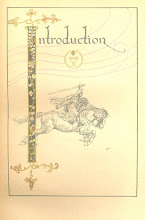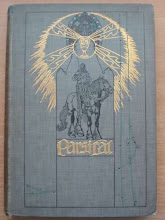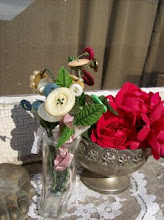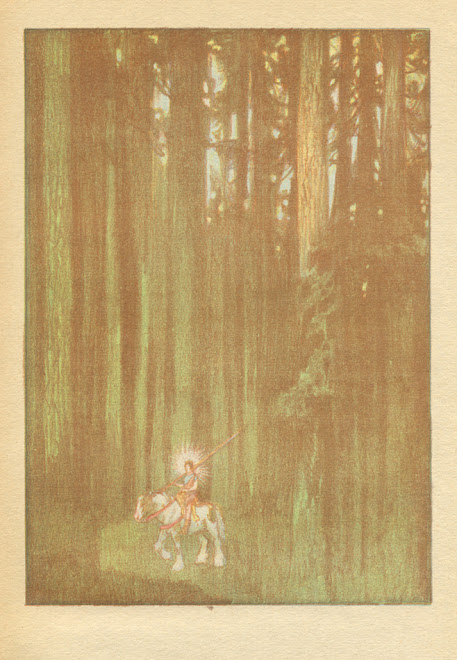Friday, May 9, 2008
The Man of Light and The Axis Mundi
The book I just read, The Man of Light in Iranian Sufism, pulled some things together for me. I've written here about the axis mundi and how it's been showing up for me archetypally lately. The book talks about that, expanding on the mystical significance of the North Pole in Sufism and other esoteric disciplines (I've run across it in shamanism, King Arthur mythology, the Egyptian Osiris story and Hermetic mythos, too). The pole is the metaphor for the axis mundi, the center of the world. The north is a metaphor for the highest spiritual places, being at the top of the world and of the heavens, and the stars at the North Pole are named as the site of the throne of God. I wanted to read about this because I used that mythology in Parsifal. I did enormous amounts of research for the book, not just in the Matter of Britain and the European Parsifal stories, but also in the possible Persian antecedents of the story (an old story called The Cup of Jamshid about a vessel which may have been an earlier Grail), possible Greek origins (the cup of kykeon, the sacred beverage of the Eleusinian mysteries, the drinking vessl again perhaps a proto-Grail or chalice), Siberian shamanism, Sufism, ancient European mother goddess and divine son mythology, the Sumerian myth of the iniation of Inanna into the underworld as a metaphor of the descent of the soul through the seven planetary circles and into the material world, and so forth. I used the Persian Zoroastrian emphasis on astrology as a celestial mirror of spiritual occurrences as a way to tie my book back to the possible Middle Eastern genesis of the myth, and I got really interested in a theory that the Arthurian body of myth may in fact have been completely inspired by the movement of the polar stars, including the bear constellations, bear in Latin being Artos. This all bubbled away for a while inside of me, then gushed out and into the book. Finding a Sufi book that talked about the same things, the pole (qutub) and the seven lights that indicate the seeker's approach to it, really excited me. The book talks about how the rainbow lights are the seven subtle organs of the inner man, the man of light who is hidden in the flesh until the spiritual seeker unearths him. Those would be the chakras, and I think the pole also refers to the awakening of the kundalini energy in the spine, and the flowering of the crown chakra. An honored shaykh in a Sufi tariqat is sometimes referred to as the pole, and so is the sheepskin upon which a person kneels when they are to be initiated into a Sufi order. In Sufi and Shia Islam, there is also said to be a hidden imam of great spiritual power (sometimes named as Archangel Gabriel) who is secreted amongst the stars in the northern sky. One ascends down into a well (the spinal column?) into the depths of one's being, and then begins to ascend, passing through a show of colorful lights (sometimes symbolized by the aurora borealis) and meeting mystic prophets associated with each chakra center (Adam, Noah, Abraham, Moses, David, Jesus and Mohammed). The final color one sees is a brilliant and radiant green, the color of the gardens of Allah, as one meets the imam, who wears one's own perfect face. Henry Corbin, the book's author, tied this Islamic mystic experience in to a similar Hermetic story, too, about meeting one's Perfect Nature, the spiritual guide which is one's highest self. Dervishes of the Turkish Mevlevi order (founded by Rumi in Konya) enact their whirling to express the motion of cosmic bodies around their central poles. I have achieved a whole new level of understanding of esoteric mysticism in general and Sufism in particular by reading this book - it tied up many loose ends for me and answered a lot of questions. The next books I want to read are Green Hermeticism, the new book about applying alchemical philosophy to the environmental movement, and the Kerenyi Dionysos book that I started a few weeks ago, blogged about briefly, then set aside in order to work on my book drafting. I think it's time to go back to it, as time permits. There were some archetypal similarities to the Dionysos myth that I found in the Hermetic stories in The Man of Light. One reason I got into Sufism in the first place was because I was interested in alchemical and Hermetic studies from my work in medievalism, and I realized through research that the origin of much of the material was in the Middle East, in al-kimiya, the earliest forerunner of modern chemistry. It got transferred to Europe via the Crusades and trade, and during the Moorish conquest and occupation. Everything is connected, and I intend to find as many of the connections as I can, because this is fascinating to me, and the basis of my life's spiritual and creative work.
Subscribe to:
Post Comments (Atom)









No comments:
Post a Comment